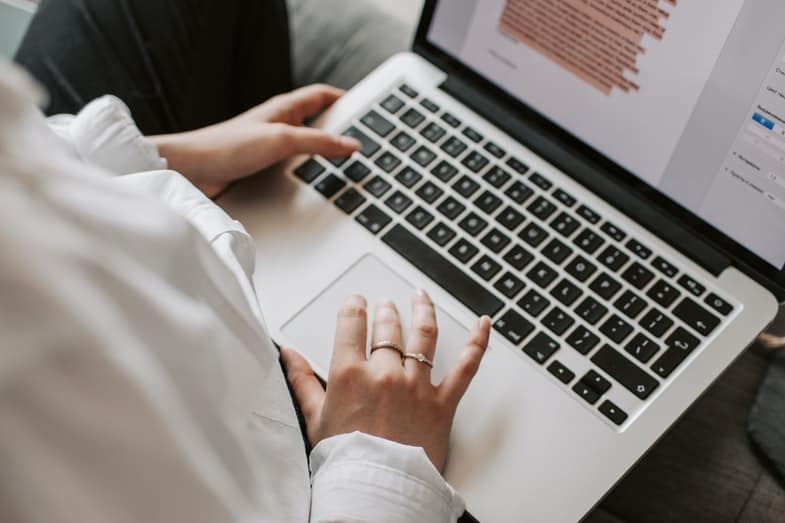How to respond to a job interview email? If you received a job interview email, then congratulations! That means they are interested in hiring you, but it’s not certain yet. In this article, I will describe how to respond in a way that improves your chances of getting the job.
How do you respond to a job interview email? Follow the 6 tips below when responding to a job interview email:
- Mention the name of your main recipient in the salutation.
- Include a greeting before starting your letter.
- Acknowledge the email you received by expressing your gratitude.
- Confirm your availability for the job interview.
- Answer all questions asked in the email.
- Send the email to all intended recipients.
The rest of this article will further tackle each of the above-mentioned items. So, read on to learn and understand how to respond to a job interview email properly.
How to Respond to a Job Interview Email
Emailing has made it very convenient for employers to find and hire someone. Job applicants are assured that their resumes will reach employers in an instant. Employers can then review resumes and get in touch with their applicants as soon as they can.
However, once you, as a job applicant, receive a job interview invite from an employer via email, do you know how to appropriately respond to it? Is it basically the same as replying to any other type of email you receive?
Well, more or less, your reply is typically the same as how you reply to other professional emails you receive. But, there are several other factors you need to consider. Let’s discuss each one of them.
1. Mention the Name of Your Main Recipient in the Salutation
In other professional emails you receive, using “Dear Sir” or “Dear Ma’am” in the salutation section is already enough. While you may also apply this when responding to a job interview invite, it is recommended that you mention the name of your main recipient.
For example, if her name is Michelle Smith, you may indicate “Dear Michelle,” “Dear Ms. Michelle,” or “Dear Ms. Smith,” in the salutation.
By main recipient, we mean the specific person you are replying to or the one who sent you the job interview email. You may notice several email addresses included in your email communication. This means that the main sender furnished a copy of the email to the bosses and other co-workers. In which case, you don’t have to mention all their names in the salutation section.
2. Include a Greeting Before Starting Your Letter
Greeting the recipient is how we all normally start a letter, whether email or handwritten, right? Unfortunately, no matter how common a greeting is, we still sometimes forget to include it. It typically happens when a co-worker emails us, and we directly reply to his question. We don’t even bother to say “Good morning” or “Good afternoon” anymore.
It is acceptable in an informal setup, such as replying to internal email communication or if you’re replying to someone close to you. But problems can occur when we get so used to this pattern. As a result, we end up omitting the greetings even when we email people who aren’t close to us.
You might feel that there’s no big deal about it. But to the person you are talking to, starting a letter with a greeting may be a sign of politeness. If you’re familiar with Dr. Wayne W. Dyer’s famous quote, it says that “If you have a choice between being right and being kind, choose kind.” We can apply the same rule when replying to emails professionally.
So, just to be safe and ensure that your reply sounds professional, make sure to start it with a greeting. Besides, how hard is it to include a greeting? You simply have to type “Good morning,” “Good afternoon,” “Good evening,” or “Good day.” Such a short sentence will surely leave a positive impression on you.
3. Acknowledge the Email You Received by Expressing Your Gratitude

Respond to a job interview email includes acknowledging the email that you received. In fact, your acknowledgment has to come first before anything else. This means that if the email you received includes several questions, you don’t immediately answer each of those questions. Instead, acknowledge receiving the entire email.
The same rule applies to your concerns that you wish to mention in your reply. Before doing so, make sure to say thank you for being selected for a job interview. Then, in a separate paragraph, enumerate each of your concerns. You typically indicate your concerns in the latter part of the email.
The acknowledgment must come after your greeting. Express your gratitude. Besides, how else are you supposed to feel after receiving such an email right? So, let your recipient know that you sincerely appreciate it.
Just imagine how many applicants must have applied for that job? Not everyone was invited for a job interview. It means that receiving a job interview invite is an achievement in itself. Therefore, there’s every reason for you to express gratitude, politeness, and friendliness.
After all, these are some of the characteristics that recruiters look for in their applicants. Both recruiters and employers would love to place friendly people in their companies.
4. Confirm Your Availability for the Job Interview
Among the questions asked by the recruiter, answering about or confirming the schedule of your job interview is the most important reply of all. In which case, you may reply in any of the following manners:
“Yes, I am available on _____[exact date]_____ at _____[exact time]_____.”
“I look forward to the job interview set on _____[exact date]_____ at _____[exact time]_____.”
You may have in mind better ways of replying. In which case, feel free to use other alternatives. The important thing is to always end up sounding polite and friendly.
If you are not available on the scheduled interview date, politely mention it in your email. Express your sincere apology for not being available. Your recruiter will understand it, especially if you are employed and can’t take a leave off at such short notice.
When suggesting a new interview schedule, here are a few pointers to remember:
1. Provide Two (2) Sets of Schedules
Informing them of your two (2) preferred dates and times will give your interviewers options to choose from. Don’t suggest schedules that will make your interviewers wait for several weeks to a month unless you’re out of town and won’t come back any time soon. Postponing your interview for a week is acceptable.
2. Choose a Day Between Tuesday and Thursday
Employers and employees typically use Mondays and Fridays for company meetings and meeting deadlines.
3. Suggest a Morning Schedule
When it comes to the exact time, set the interview in the morning. It doesn’t have to be early morning. A mid-morning schedule is the most ideal of all.
Avoid scheduling in the afternoon unless it is the recruiter who suggested it. The reason is that, in most cases, our positive aura comes out in the morning. I mean, who wouldn’t feel great after a good night’s rest, a refreshing bath, and a sumptuous breakfast, right?
In the morning, we haven’t used up all our energy for the day yet. Therefore, both you and your interviewer are in a positive state. If this is the case, there’s a big chance that the interview will turn out smooth and positive.
5. Answer All Questions Asked in the Email
Check the content of the email sent to you thoroughly. Your recruiter may have other concerns aside from the schedule of your interview. He or she may instruct you to bring or send additional requirements. In which case, make sure that you comply with the requirements and deliver them promptly.
If you can’t accomplish the recruiter’s other requests, make sure to mention them in your reply. Indicate why you can’t accomplish them on time and set a schedule when to deliver them all.
Also, once you set a schedule, don’t move it to a later date anymore. Such behavior will leave a negative impression on you. It may mean that you’re not efficient when it comes to meeting deadlines.
So, again, make sure to answer each question asked in the email. You might want to read and review the email sent to you several times to ensure that you will not overlook a single thing. That way, your recruiter will have the impression that you have a keen eye for detail and that you are a responsible person.
6. Send the Email to All Intended Recipients
You may notice other email addresses indicated at the upper portion, specifically in the “CC” bar. Those are the email addresses of other concerned parties. They could be the department head, the manager, and the human resource team, among others. All of them are waiting for your favorable response. So, it is only right not to exclude them in your reply.
This means that when you send your response, make sure to click “Reply All” instead of only clicking the “Reply” button. This way, you can ensure that everybody will receive your email.

Other Tips When Responding to a Job Interview Email
Aside from the guidelines mentioned above on how to respond to a job interview email, here are additional reminders for you:
- Make sure to reply in less than 24 hours. Doing so is a sign of your interest in getting interviewed. It is an indication that you check your email regularly, too. Generally, it is an indication of being a responsible person.
- Reply in a direct manner. Make sure not to include unnecessary details. Don’t say, “I would like to express my sincere apology for not being able to reply as soon as possible, as I had to attend to my children’s needs.” They know that you have other important things to do, but you don’t have to specify them. Stick to the topic. Answer the questions directly. It is an indication of being an efficient person.
- If the recruiter did not indicate any further instructions in the email, feel free to ask about it in your email response. You may ask if there’s anything you need to bring on the day of your interview. Or ask if there are other requirements you need to submit via email.
- Don’t forget to include a professional closing. You may say, “Looking forward to meeting you soon,” “Hoping for your favorable response,” or anything else that you deem appropriate. Also, don’t forget the most important thing–write “Thank you” as your last sentence before indicating your signature.
How to Respond to a Job Interview Email Sample
Here’s a sample reply on responding to a job interview email:
Dear Ms. Smith,
Good morning.
Thank you for your interest in interviewing me for the Marketing Manager position at JKL Pty. Ltd. I am available this Wednesday, August 19, 2020, at 10:00 a.m., and I look forward to this interview to further discuss the position.
Please let me know if I need to send any additional information or requirement before the interview.
Again, I look forward to meeting you and the rest of the team.
Thank you.
Sincerely yours,
Peter Parker
Phone: (555) 789-4321
Conclusion – How to Respond to a Job Interview By Email
To recap, how to respond to an email for a job interview? Follow these 6 tips when responding to the email:
- Mention the name of your main recipient in the salutation.
- Include a greeting before starting your letter.
- Acknowledge the email you received by expressing your gratitude.
- Confirm your availability for the job interview.
- Answer all questions asked in the email.
- Send the email to all intended recipients.
But then again, the most important of all is to always sound polite and friendly in your email response. Remember that recruiters and employers will not only look at your work experience.
More than anything else, they are looking at your positive characteristics. They are assessing how fit you are in their company culture and if you can get along with all their other employees.
So, be careful in replying to a job interview email and always remember to be polite and friendly.
Related reading:
Currently Employed – How to Get a Job If You are Still Employed
How to Respond to a Job Offer? [Email or Verbal]

![How to Respond to a Job Offer? [Email or Verbal] how to respond to a job offer](https://howchimp.com/wp-content/uploads/2021/04/how-to-respond-to-a-job-offer-300x200.jpg)

![Oh I See [What Does It Mean and How to Respond?] oh i see](https://howchimp.com/wp-content/uploads/2021/04/oh-i-see-300x200.jpg)


